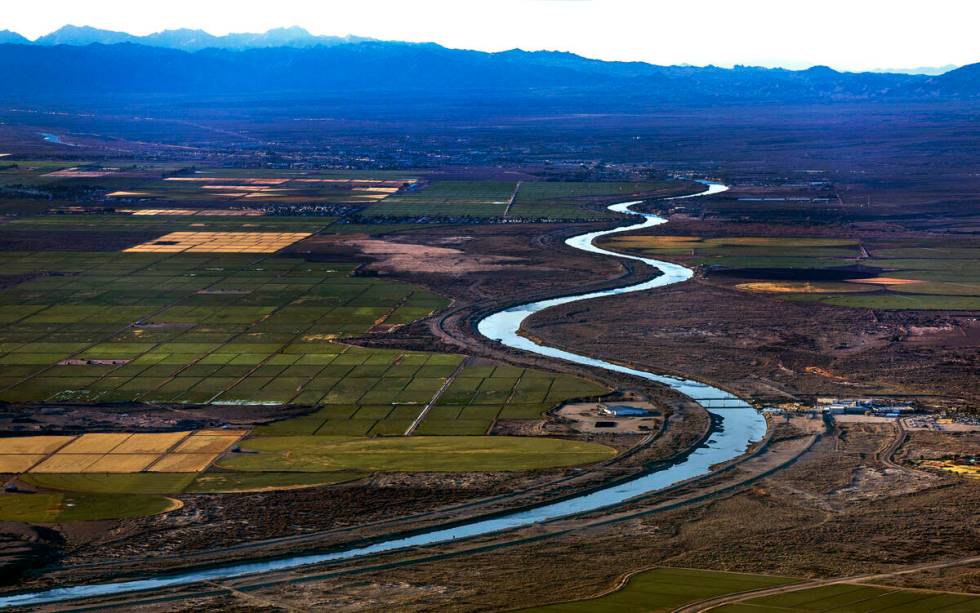What we know about the bill that could limit Las Vegas water use

A sweeping water conservation bill that would give Las Vegas Valley water managers the unprecedented ability to limit how much water single-family residential homes in Southern Nevada could use continues to make its way through the state Legislature.
Assembly Bill 220 would give the Southern Nevada Water Authority the power to limit residential water use to 0.5 acre-feet per home per year in Clark County during times when the federal government has declared a water shortage along the drought-stricken Colorado River that supplies about 90 percent of Southern Nevada’s water.
If approved, Nevada would be the first state to give a water agency the power to cap the amount of water that flows into individual homes.
But what those restrictions could look like and how they would be implemented remains to be seen.
The bill cleared the Assembly on a 30-12 vote last month and still needs approval in the Senate and by the governor. The Senate Natural Resources Committee heard an amended version of the bill Tuesday evening.
Here’s a quick look at what we know — and what we don’t — about how those unprecedented water use limits could work should the bill be approved by the Legislature and signed into law.
When could those restrictions happen?
If AB220 does become law, water use limits would not immediately be placed on homes in Southern Nevada.
The decision to implement those restrictions would be up to the Southern Nevada Water Authority’s board of directors, which is made up of elected officials from municipal governments in Southern Nevada.
Bronson Mack, spokesman for the water authority, said the intent of the bill is to give the agency an extra tool should the federal government further reduce Nevada’s share of the Colorado River in the future — such as the cuts the U.S. Bureau of Reclamation is considering to protect hydropower infrastructure at the dams at Lake Mead and Lake Powell.
“It is not our expectation that it gets implemented right away. It is our expectation that should our shortage conditions increase in severity, meaning we’re taking larger shortages, that we have this additional tool to help manage that water demand,” Mack said.
How would those restrictions work?
Exactly how those water limits would work remains to be seen.
The bill does not offer any specifics as to how the restrictions would be implemented or whether it could include hard cutoffs of water delivery after reaching that half-acre-foot limit.
Speaking during the Senate committee hearing Tuesday evening, water authority Deputy General Manager Colby Pellegrino said the enforcement of the water cap most likely would come via a flow limiting device, which would still allow water to flow into houses but at lower amounts.
“It would be something that still allows you to get enough water for your basic health and human safety needs,” Pellegrino said.
Who would be affected?
The water authority says the top 20 percent of single-family residential water customers in the valley would likely be affected by the restrictions. That’s about 115,000 homes in total, according to the authority.
A half-acre-foot of water translates to roughly 163,000 gallons of water. About 80 percent of homes in Southern Nevada use less than 163,000 gallons each year, with the average home in the valley using 130,000 to 132,000 gallons annually, according to the authority.
Single-family homes account for 44 percent of the water used in the valley, and the top 10 percent of residential customers use about 36 percent of all water in the residential sector, according to the water authority.
“It is our largest water use sector, and we can achieve additional water savings by really reducing the top 20 percent,” he added.
Who wouldn’t be affected?
The bill would only apply to homes considered single-family residential, which would mean the water limits would not affect commercial properties or multifamily residences like apartment complexes and condos.
Mack said the majority of the water used in commercial properties and apartment units is used indoors, which means that it can be treated and returned to Lake Mead as part of the valley’s return flow system that allows the region to use an extra gallon of water for every gallon of treated wastewater returned to the reservoir.
An amendment expected to be adopted to the bill this week would allow certain homes to apply for waivers, too. Mack said that carve-out was sought in order to address certain situations where homes under the single-family designation have special needs and generally higher indoor water use, such as group homes.
What about restricting new building to save water instead?
Putting limits on new homes and businesses isn’t something the water authority is looking for at this point.
Part of that equation is that new homes use far less water than those built even a decade ago. Changes to home building codes in recent years have sought to reduce how much water each newly built home uses. Those changes include size limits for new pools and not allowing any living grass at newly built homes throughout the valley. The only place where new turf is allowed to be installed is in schools, parks and cemeteries.
“By setting these development codes or updating these development codes over the past few years, we have made sure that new homes built today are much more water efficient than homes built 10, 20, 30 years ago,” Mack said.
What about the septic tanks?
The original version of the bill would have required about 5,000 septic tank owners in the valley who receive Colorado River water through a municipal water supplier to abandon their septic system and tap into the sanitary sewer system.
But after pushback from septic tank owners, the bill is set to be amended this week to instead make the conversion program voluntary.
Contact Colton Lochhead at clochhead@reviewjournal.com. Follow @ColtonLochhead on Twitter.